When it comes to changes or growths on the skin, it’s common for people to confuse skin tags with moles. Although both are generally harmless, they are distinct in their appearance, causes, and medical implications. Understanding these differences is important for recognising any potential concerns and knowing when to seek medical advice.
In this article, we’ll explore what skin tags and moles are, how to tell them apart, what causes them, and what to do if you notice changes. Whether you’ve spotted a new bump or are just curious, this guide will help you distinguish between the two.
What Are Skin Tags?
Skin tags, medically known as acrochordons, are small, soft, benign growths that usually hang off the skin. They are typically flesh-coloured or slightly darker and have a smooth or slightly wrinkled surface. Skin tags are connected to the skin by a thin stalk called a peduncle.
They most commonly appear in areas where skin rubs against skin or clothing, such as:
- The neck
- Underarms
- Eyelids
- Under the breasts
- Groin area
Skin tags are not contagious and tend to be more common in adults, especially those who are overweight, have diabetes, or are pregnant (due to hormonal changes).

What Are Moles?
Moles, or melanocytic naevi, are pigmented skin lesions that occur when melanocytes (the pigment-producing cells in the skin) grow in clusters. Unlike skin tags, moles can be flat or raised, and they vary widely in colour — from pink to dark brown or black.
Moles can appear anywhere on the body and may be present at birth (congenital moles) or develop over time. Most people have between 10 to 40 moles by adulthood.
Some moles remain unchanged for years, while others may gradually change in size, colour or shape. While most are harmless, certain types of moles can develop into melanoma, a serious form of skin cancer.
Key Differences Between Skin Tags and Moles
Here’s a breakdown of the main differences between the two:
Appearance
- Skin tags: Small, soft, flesh-coloured or slightly darker; often appear to dangle from the skin.
- Moles: Can be flat or raised; usually round or oval; colour ranges from light brown to black.
Texture
- Skin tags: Soft and movable; may have a stalk.
- Moles: Can be smooth or rough; usually more firmly attached to the skin.
Location
- Skin tags: Found in skin folds (neck, armpits, groin, eyelids).
- Moles: Can appear anywhere on the body, including the scalp and under nails.
Causes
- Skin tags: Often caused by skin friction; associated with age, obesity, pregnancy, and insulin resistance.
- Moles: Caused by clustering of melanocytes; may be influenced by genetics and sun exposure.
Risk
- Skin tags: Not cancerous and rarely problematic.
- Moles: Usually benign but some can become cancerous (e.g., atypical moles or dysplastic naevi).
Removal
- Skin tags: Can be removed easily for cosmetic reasons or if irritated.
- Moles: Should only be removed by a professional, especially if suspicious.
Why Do They Appear?
Skin Tags:
Skin tags often result from friction or irritation. This is why they are common in areas where skin rubs together or against clothing. Hormonal changes during pregnancy and high levels of insulin in people with type 2 diabetes can also contribute to their development.
Some people may be genetically predisposed to skin tags, and they are more prevalent in middle-aged and older adults.
Moles:
Moles develop when melanocytes grow in clusters. They may form due to genetic factors, sun exposure, and hormonal changes, particularly during puberty or pregnancy.
Sunburns and frequent sun exposure can increase the number of moles and the risk of some becoming cancerous. Fair-skinned individuals or those with a family history of melanoma should monitor their moles more carefully.

Should You Be Concerned?
While both skin tags and moles are usually harmless, any new growth or change in the skin should be evaluated, especially in moles. Moles that change in shape, colour, size, or become itchy, painful, or start bleeding may require further examination.
Use the ABCDE rule to assess moles:
- A – Asymmetry: One half doesn’t match the other.
- B – Border: Edges are irregular or blurred.
- C – Colour: Multiple colours or uneven pigmentation.
- D – Diameter: Larger than 6mm (about the size of a pencil eraser).
- E – Evolving: Changes over time in size, shape, or colour.
Skin tags do not turn into cancer. However, they may become irritated from friction or accidentally torn, which can cause discomfort or minor bleeding. If this happens regularly, removal might be considered.
Diagnosis and Treatment
Diagnosis:
Most skin tags and moles can be diagnosed through visual inspection by a GP or dermatologist. In some cases, a dermatoscope may be used for a closer look. If there is any suspicion of malignancy in a mole, a biopsy may be recommended.
Treatment:
Skin Tag Removal Options:
- Cryotherapy (freezing off)
- Cauterisation (burning off)
- Ligation (cutting off blood supply)
- Surgical removal with scissors or scalpel
These procedures are generally safe and performed quickly in a clinic. They are usually considered cosmetic and not covered by Medicare.
Mole Removal Options:
- Excision (surgical removal)
- Laser removal (only for benign, non-cancerous moles)
- Shave removal (for raised moles)
If there’s any chance the mole is cancerous, excision is preferred and the tissue is sent for biopsy. Medicare may cover mole removal if there’s a medical reason.
Prevention Tips
While not all skin tags or moles can be prevented, you can take some steps to reduce your risk.
To reduce skin tags:
- Maintain a healthy weight.
- Wear breathable, loose-fitting clothing.
- Manage blood sugar levels if diabetic.
- Avoid excessive skin friction.
To reduce mole risks:
- Apply sunscreen daily (SPF 30 or higher).
- Avoid peak sun hours (10 am – 4 pm).
- Wear protective clothing and hats.
- Avoid tanning beds.
- Monitor your skin regularly and photograph moles to track changes.
When to See a Doctor
You should see a doctor if:
- A mole changes in appearance (ABCED signs).
- A mole or skin tag becomes painful, itchy, or bleeds without injury.
- You notice a new or unusual growth.
- A skin tag causes discomfort or cosmetic concern.
It’s also wise to have an annual skin check with a GP or dermatologist, especially in Australia, where the high UV index increases the risk of skin cancer.

Summary: Comparing Skin Tags and Moles
Below is a text-style summary comparing the two:
Skin Tags
- Colour: Flesh-toned or slightly darker
- Shape: Small, soft, may dangle from skin
- Location: Neck, armpits, groin, eyelids
- Cause: Friction, hormonal changes
- Cancer Risk: None
- Treatment: Simple removal, cosmetic only
Moles
- Colour: Light brown to black
- Shape: Flat or raised, round or oval
- Location: Anywhere on body
- Cause: Clustering of melanocytes
- Cancer Risk: Some can become melanoma
- Treatment: Professional removal, may be medically necessary
Final Thoughts
Understanding the differences between skin tags and moles is essential for maintaining good skin health. While both are usually benign, staying informed and monitoring your skin for changes can help detect early signs of trouble. With Australia having one of the highest skin cancer rates in the world, regular skin checks are not just recommended — they’re vital.
When in doubt, consult your GP or dermatologist. A quick check can give peace of mind and ensure your skin stays healthy and safe.
At Medix Clinic, we offer a comprehensive range of professional skin and cosmetic treatments in Melbourne, tailored to your unique needs. Our services include effective acne scarring treatment in Melbourne, advanced scar treatment in Melbourne, and cutting-edge radio frequency microneedling in Melbourne to stimulate skin repair and regeneration. We also specialise in skin needling in Melbourne, non-surgical skin tightening in Melbourne, and safe skin tag and mole removal in Melbourne.
For pigmentation concerns, we provide precise pigmentation removal in Melbourne, helping you achieve a more even skin tone. To restore your skin’s natural radiance, our expert skin rejuvenation treatments in Melbourne are designed to revitalise and refresh. Additionally, enhance your smile with our professional LED teeth whitening in Melbourne, delivering safe and noticeable results.
At Medix, our goal is to deliver visible outcomes using evidence-based technologies, ensuring you feel confident in your skin.


